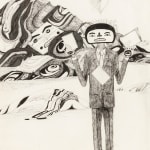-
Artworks
LAWRENCE PAUL YUXWELUPTUN (1957-) COAST SALISH / OKANAGAN, COWICHAN / SYILX FIRST NATIONS
Study for "An Indian Game (Juggling Books)", 1996ink on paper, 17 x 14 in (43.2 x 35.6 cm), framed
dated and signed, "97 YUXWELUPTUN";
verso with graphite sketch of a wood structure [?].Lot 140
ESTIMATE: $2,000 — $3,000
PRICE REALIZED: $5,280.00Further images
Aside from medium and size, the formal correspondence between this meticulously drawn study and the finished canvas are considerable. Only the left portion of the finished work is seen here,...Aside from medium and size, the formal correspondence between this meticulously drawn study and the finished canvas are considerable. Only the left portion of the finished work is seen here, with the depiction of the "apple-headed Indian" in Yuxweluptun's artwork; this reflects a pejorative term used to describe someone perceived as betraying their race, who is, like an apple, white on the inside. [1] This theme resonates deeply with the racial questions central to many of Yuxweluptun's most significant paintings. It is a sardonic indictment of Indigenous individuals who gain prominence but do not use their platform to advance Indigenous causes. The depiction of the figure as a juggler, however, implies a feeling of sympathy by the artist. The act of “juggling” underscores the delicate and challenging position such persons might find themselves in, grappling with identity, societal expectations, and personal ambitions.
1. Karen Duffek and Tania Willard, Unceded Territories: Lawrence Paul Yuxweluptun (Vancouver: Museum of Anthropology, UBC, 2016), 2016, p. 32.References: The canvas for An Indian Game (Juggling Books), 1996 has been widely reproduced including on Yuxweluptun’s own website; in Karen Duffek and Tania Willard, et. al., Unceded Territories: Lawrence Paul Yuxweluptun, (Vancouver: Museum of Anthropology, UBC, 2016), illustrated p. 76, commentary on p. 28 & 32. Also illustrated in Marsha Lederman, "Yuxweluptun’s exhibition brings you face to face with indigenous history,” The Globe and Mail, 15 May 2016; Samia Madwar, “Lawrence Paul Yuxweluptun exhibit captures Vancouver's surging interest in Indigenous art,” CBC Arts, 26 May 2016; “Vancouver Entrances: Lawrence Paul Yuxweluptun and Beau Dick,” Canadian Art Magazine, 14 July 2016. For the artist’s first major showing, see Charlotte Townsend-Gault, et al., Lawrence Paul Yuxweluptun: Born to Live and Die on Your Colonialist Reservations, (Vancouver: Morris and Helen Belkin Art Gallery, UBC, 1995); For the artist’s own commentary on his drawing process, see “Drawing” in Petra Wilson, ed., Lawrence Paul Yuxweluptun: Neo-Native Drawings and Other Works, (Vancouver: Vancouver Contemporary Art Gallery, 2010), p. 7.
It has been suggested that the right figure of the finished canvas may be a self portrait (Duffek, p. 32). We postulate that both figures may be self portraits of the artist. It is possible that Yuxweluptun is not making an indictment of those around him but that this is a form of agonized self-analysis. He stands as one of the few Indigenous artists currently achieving such significant success in his domain. Thus, his work might delve into his own internal struggle, contemplating whether his prominence is truly earned or if he is merely being tokenized in the art world.
Provenance
Acquired directly from the artist by the present Private Collection, Toronto, 2001.
Join our mailing list
* denotes required fields
We will process the personal data you have supplied in accordance with our privacy policy (available on request). You can unsubscribe or change your preferences at any time by clicking the link in our emails.






